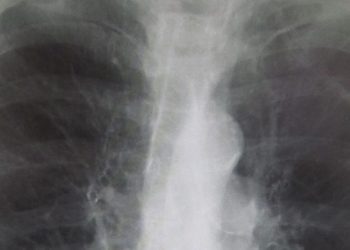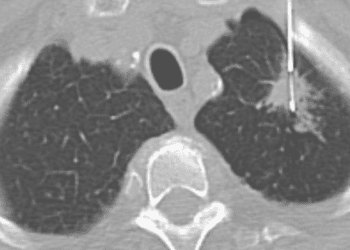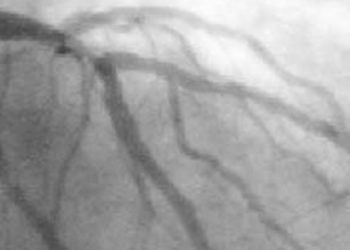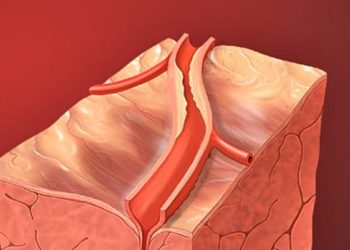2 Minute Medicine Rewind September 8 – September 14, 2014
In this section, we highlight the key high-impact studies, updates, and analyses published in medicine during the past week.
Angiotensin–Neprilysin Inhibition versus Enalapril in Heart Failure
The PARADIGM-HF trial
Inhibition of neprilysin, an endopeptidase that degrades endogenous vasoactive peptides, has been shown to counteract the maladaptive vasoconstriction, sodium retention, and remodelling processes associated with chronic heart failure (CHF). Clinical trials testing the inhibition of neprilysin in conjunction with angiotensin-converting-enzyme (ACE) inhibition previously demonstrated serious angioedema side effects. This trial is the first to test the combination of a neprilysin inhibitor (AHU377) with an angiotensin-receptor blocker (valsartan) in the drug combination LCZ696. In this randomized controlled trial, 8,442 adult patients with NYHA class II, III, or IV heart failure and an ejection fraction <40% were assigned to either LCZ696 or enalapril in addition to recommended therapy. The trial was stropped prematurely after 27 months when it was shown that compared to the enalapril group, the LCZ696 cohort had significantly fewer patients reaching the primary outcome of hospitalization for CHF or death from cardiovascular causes (21.8% vs. 26.5%, HR: 0.80, 95% CI: 0.73-0.87, P<0.001). All-cause mortality was 21.8% in the intervention group versus 26.5% in the control group (HR: 0.84, 95% CI: 0.76-0.93, P<0.001). LCZ696 did result in higher rates of hypotension and non-serious angioedema but also caused fewer instances of renal impairment, hyperkalemia, and cough than enalapril. This study therefore shows that LCZ696, a combination neprilysin inhibitor and ARB, was superior to enalapril in reducing the risk of death and hospitalization for CHF exacerbations.
Withdrawal of Inhaled Glucocorticoids and Exacerbations of COPD
Severe chronic obstructive pulmonary disease (COPD) is currently treated with an inhaled glucocorticoid and an additional bronchodilator, usually either a long-acting beta-agonist (LABA) or a long-acting muscarinic antagonist (LAMA). To date, however, there has not been a definitive study demonstrating whether glucocorticoids contribute an additional benefit to patients on dual bronchodilator therapy. In this randomized controlled trial, 2,485 patients with history of COPD exacerbations received triple therapy (tiotropium, salmeterol, and fluticasone) for 6 weeks. They were then randomly assigned to a fluticasone taper over 12 weeks versus continuation of triple therapy. Investigators found that withdrawal of the glucocorticoid did not significantly increase the risk of having a COPD exacerbation within the 12-month study period compared to continuation of the glucocorticoid (HR: 1.06, 95% CI: 0.94-1.19). However, the study did find that after 52 weeks, the glucocorticoid withdrawal group continued to show a significantly reduced forced expiratory volume in 1 second (FEV1) compared to the glucocorticoid continuation group (mean FEV1 reduction of 38 ml, P = 0.001). This study therefore suggests that in comparison to long-term triple therapy, the use of dual bronchodilator agents with tapered glucocorticoid treatment may result in a lower FEV1 but does not appear to put COPD patients at greater risk of having exacerbations.
Young Adult Sequelae of Adolescent Cannabis Use: An Integrative Analysis
With the growth in legalization and availability of medical cannabis, the number of cannabis users, both adults and adolescents, may be increasing. The effects of cannabis use in adolescents, however, remains poorly understood due to limits in existing data. In this cohort study, investigators integrated data from three large longitudinal adolescent cohorts in Australia and New Zealand in order to investigate the association between frequency of cannabis use before the age of 17 and development outcomes up to the age of 30. There were 2,537 participants for one set of outcomes and 3,765 total participants for the other outcomes. Investigators found that compared with individuals who had never used cannabis, daily adolescent cannabis users were significantly less likely to complete high school (OR: 0.37, 95% CI: 0.20-0.66) or obtain a university degree (OR: 0.38, 95% CI: 0.22 – 0.66 after covariate adjustment for high school completion). They had significantly increased rates of later cannabis dependence (17.95, 9.44 – 34.12), use of other illicit drugs (7.80, 4.46-13.63), and suicide attempts (6.83, 2.04-22.90). These results show that early cannabis use is associated with several adverse sequelae that persist past adolescence, calling for increased attention to reducing adolescent cannabis use.
Darapladib is a selective inhibitor of the Lipoprotein-associated Phospholipase A2 (Lp-PLA2), an enzyme that is thought to contribute to atherosclerosis development and plaque instability via its effects on the inflammatory pathway. Darapladib appears to prevent expansion of the necrotic core of plaques in earlier studies but most recently did not show a significant protective effect for cardiac or stroke outcomes in patients with stable coronary heart disease. The effect of Darapladib in patients who have had an acute coronary syndrome (ACS) has not yet been studied. In this muticenter, international randomized controlled trial, 13,026 patients who had had an ACS within 30 days were randomized to receive either once-daily Darpladib or placebo in addition to standard-of-care therapy. After a median follow-up period of 2.5 years, investigators found that there was no significant difference in the risk of developing the primary endpoint of either death from coronary heart disease, myocardial infarction, or urgent coronary revascularization for myocardial ischemia (16.3% vs. 15.6%, HR: 1.00, 95% CI: 0.91-1.09, P=0.93). There was no significant difference between the groups for the composite endpoint of cardiovascular death, MI, or stroke, as well as all-cause mortality. This therefore demonstrates that inhibition of Lp-PLA2 with Darpladib does not appear to significantly reduce the rates of major coronary events in patients who have had a recent ACS episode.
Targetable Kinase-Activating Lesions in Ph-like Acute Lymphoblastic Leukemia
Acute lymphoblastic leukemia (ALL) is a heterogeneous disease with many genetic etiologies. Philadelphia chromosome-like acute lymphoblastic leukemia (Ph-like ALL) is one such variant that is similar in gene expression profile to the more well-studied BCR-ABL1 subtype and is associated with worse outcomes. However, its underlying genetic mutations and responsiveness to tyrosine kinase inhibitor therapies are not well understood. In this study, investigators performed a genomic profiling of 1,725 patients who had precursor B-cell ALL and more detailed analysis of 154 patients with Ph-like ALL. This was followed by further in vitro and in vivo studies with mice cells and xenografts of human Ph-like ALL. Researchers found that Ph-like ALL was more frequent and more fatal in young adults and adolescents compared with children (27% incidence vs. 10%) and displayed kinase-activating alterations in 91% of patients. Expression of these fusion proteins (which included ABL1, ABL2, CSF1R, PDGFRB, JAK2, among others) resulted in cytokine-independent proliferation that was responsive in vitro to tyrosine kinase inhibitors including dasatinib, ruxolitnib, and crizotinib depending on which fusion protein was expressed. This study therefore reveals that Ph-like ALL, although is defined by several possible genomic alterations, affects a limited number of pathways with effects that are alterable with existing tyrosine kinase inhibitors. These results inspire opportunities for further trials for treatment of this disease.
Image: PD
©2012-2014 2minutemedicine.com. All rights reserved. No works may be reproduced without written consent from 2minutemedicine.com. Disclaimer: We present factual information directly from peer reviewed medical journals. No post should be construed as medical advice and is not intended as such by the authors or by 2minutemedicine.com. PLEASE SEE A HEALTHCARE PROVIDER IN YOUR AREA IF YOU SEEK MEDICAL ADVICE OF ANY SORT.







